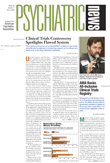The Neurological Devices Panel of the Food and Drug Administration (FDA) voted last month to recommend approval of an application by Cyberonics Inc. to market its vagus nerve stimulation (VNS) therapy system for the“ adjunctive long-term treatment of chronic or recurrent depression.” However, following significant discussion, the panel voted 5-2 to recommend several conditions for the approval.
The panel recommended that the FDA limit use of VNS to those patients who have failed four or more trials of traditional modalities for treatment-resistant depression—any combination of medications or electroconvulsive therapy—prior to using VNS. In addition, the panel stipulated that implantation of the device should be done only by surgeons with specific training appropriate to the VNS device and that primary care providers should be trained in the electronic programming of the VNS.
Moreover, the panel called for the creation of a patient registry, similar to ones already required for cardiac pacemakers, and provision of identification cards to patients noting the implantation of a medical device.
VNS therapy for depression has been under investigation for several years (Psychiatric News, September 5, 2003) with Houston-based Cyberonics leading the way. The Cyberonics VNS system, which is already approved for the treatment of medication-refractory epilepsy, involves implantation of a device that is fundamentally identical to a cardiac pacemaker in the left shoulder. However, instead of threading the device's electrode downward through blood vessels to the heart, the VNS electrode is threaded through the shoulder muscles to the base of the neck, where the electrode is attached to the left vagus nerve. The vagus nerve receives electrical stimulation for 30 seconds, followed by a five-minute rest, then another 30 seconds of stimulation, with the cycle continually running, 24 hours a day, every day.
Two studies were submitted that detailed the use of VNS for treatment-refractory depression, the first of which was an open-label, uncontrolled feasibility study involving 60 patients.
The second study—deemed the pivotal study for the approval application—involved two phases. It began with an acute, randomized, controlled phase in which 235 patients were implanted with the VNS system and then randomly assigned to having the unit either activated or not turned on. For 10 weeks the patients underwent VNS therapy or sham stimulation. The second phase of the pivotal study involved any patient who completed the 10-week phase and elected to continue with open-label, active VNS therapy.
Patients treated with VNS had an average improvement of 23.4 percent in depression rating scale scores, compared with an 8 percent improvement in the scores of those who did not receive active stimulation.
A large number of secondary outcomes confirmed improvement as well. As measured by the 24-Item Hamilton Depression Rating Scale (HamD-24), 30 percent of patients receiving VNS achieved a response— defined as a 50 percent or greater reduction in the HamD-24 score—and 17 percent achieved a complete response—defined as a final HamD-24 score of 9 or under. Of those not receiving stimulation, only 13 percent achieved a response, and only 7 percent met criteria for a complete response.
The safety and tolerability of the VNS system were documented when the device was approved for epilepsy in 1997. Since that time, more than 22,000 patients have accumulated nearly 56,000 patient-years of experience with the device.
Nearly 70 percent of patients in the pivotal study on VNS therapy experienced voice difficulties, often described as a hoarseness or raspy quality in speaking. Nearly 30 percent reported coughing as an adverse event. Other less frequently experienced adverse events including breathing difficulties and irregular heart rhythms.
In addition, the panel noted that 3.5 percent of the patients in the VNS clinical trials attempted suicide; however, this rate is not different from the rate of suicidal attempts during clinical trials for patients on antidepressant medications.
In addition, patients undergoing surgical implantation of the VNS device are at risk for postoperative, surgically related events such as pain or numbness at the incision site, infection, heart rhythm disturbances, pneumonia, and voice alteration.
The most commonly reported adverse event reported in the VNS clinical trials was worsening depression. ▪
